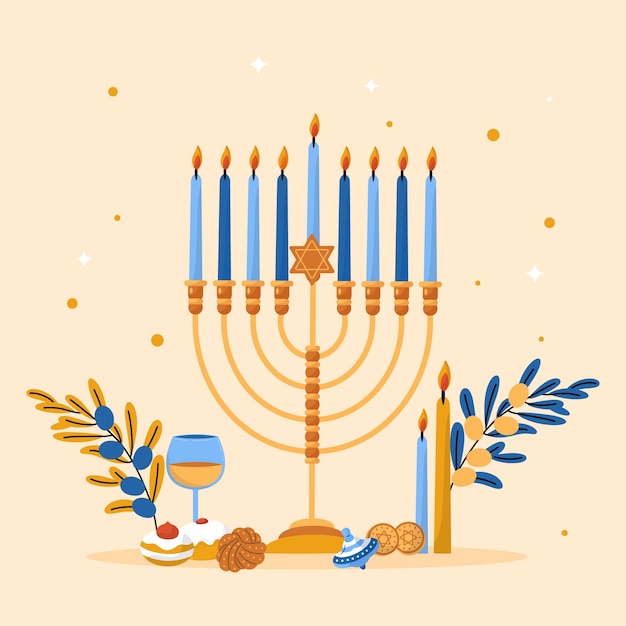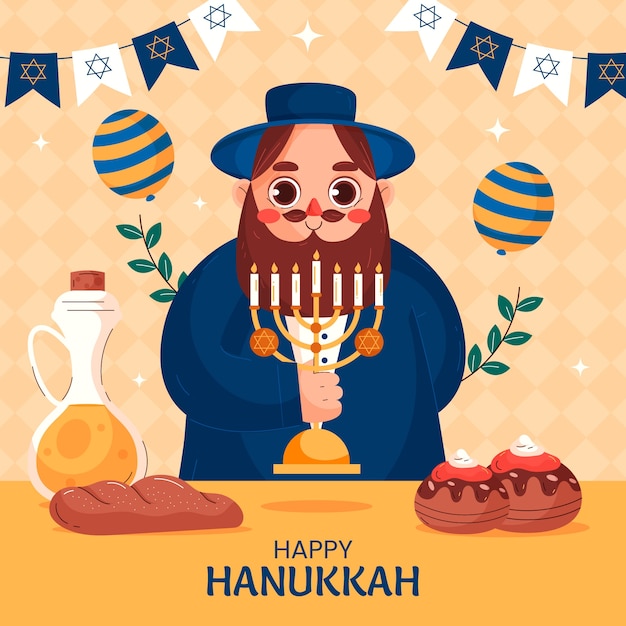Bitterdine
Hanukkah 2023, the Oil Miracle
7 months and 29 days days to light your Hanukkah Menorah!
Hanukkah, otherwise spelt Hannukah or Chanukah, is one of the prominent events in the Jewish lunisolar calendar, celebrated on the 25th day of Kislev, or the end of November to December, when referring to the Gregorian calendar. The 8-day celebration is of high importance to the Jewish community, marking the day the Maccabees rebelled against their...
Data extracted from the Freepik search engine from the last year.

Discover how Jewish people celebrate Hanukkah with these resources
-

Menorah
Menorahs are a very distinctive image of Hanukkah. The elegance of burning candles, blue and gray backgrounds complete the beauty of these special candelabra to celebrate this Jewish festivity. Get any of these high-quality images and use them as desktop or Zoom wallpapers, greeting cards, posters…
-

Challah
Celebrate Hanukkah and Shabbat eating challah, a tasty bread full of flavor. This collection of mouth-watering challah images provide a colorful touch to your Hannukah-related projects, greeting cards, posters, adverts and collages.
-

Dreidel
Dreidels are one of the most typical Hanukkah items. Celebrate this festive occasion playing with your loved ones and making use of these images with dreidels. Candles, menorahs, blue hues, and sufganiyots complete the pictures to provide you with everything you need to create your Hanukkah greeting cards.
-

Torah
Discover these captivating Torah photos, each frame preserving the essence of ancient wisdom and timeless teachings. Ideal for educational resources, these images illustrate traditions, rituals, and the sacred texts’ profound significance.
-

Hanukkah background
Keep the candle burning with a purposeful Hanukkah background, specially designed for the Jewish celebration. They will do well to highlight the importance of a special event, party, or feast, providing a backdrop for flyers, posters, and zoom backgrounds.
-

Hanukkah clip art
Explore a vibrant assortment of Hanukkah clip arts capturing the joyous spirit and traditions of the festival. Perfect for enhancing presentations, flyers, social media posts, and educational materials, these delightful visuals illuminate the celebration’s essence.
-

Hanukkah card
Who doesn’t feel special when receiving a personalized card? Take a look at these fully customizable Hanukkah card designs for a special Jewish celebration and make someone’s day unique. What will you say on your Hanukkah card?
-

Hanukkah cartoon
Embrace the warmth and cheer of Hanukkah by incorporating these adorable and engaging Hanukkah cartoons into your projects. They offer a playful take on the holiday, perfect for greeting cards, children’s educational materials, social media posts, and more.
Symbols
Exploring the Symbolism of Hanukkah and Judaism in depth
Hanukkah Color Palette





Dark Cornflower Blue, provides the atmosphere
This strong tone of blue comes from the cornflower’s flower. As it sways from side to side in the steady breeze, its hue reflects the atmosphere of tranquility and contemplation it finds itself in. It plays a vital role in the color palette, providing a dark tone in contrast to other more radiant colors. Perhaps a supportive color such as this could bring balance to your composition as a whole, working with elements and creating contrast against lighter tones. Audiences will enjoy the timeless feel this color brings to your creative projects, perhaps motivating positive thoughts. Over all, a complimentary hue to your Hanukkah themes.

Hanukkah history
Hanukkah is a time for the Jewish community to remember a series of events that highlights the determination of a community against all odds. The stories of sacrifice and miracles have become legendary, with the revolt against tyranny, the battles won by an outnumbered revolution army, and the miracle of the Menorah that burned for eight full days, an act of God. Today Jews all around the world stop to remember, lighting a Menorah candle on each of the eight days of the celebration, exchanging gifts, and spending time with each other. So without further ado, let’s step back into history and hear Hanukkah’s story. But do you know who celebrates Hanukkah? Hanukkah is primarily celebrated by the Jewish community around the world.
Antiochus III
The Jewish people are relieved of Egyptian rule and Antiochus III is welcomed into the city of Jerusalem
The land of Israel found itself caught between the Greek Seleucid ruler Antiochus III, King of Syria, and the Egyptians in a battle over dominance in the region. With the Egyptians beaten and turned away, Antiochus III was welcomed into the city of Jerusalem. It seemed the people of Israel were happy it was him and not the Egyptians, having suffered crippling taxation from them in the past. Antiochus III announced that all Jews were free to practice their religion. He even went as far as dishing out tax exemptions to the elderly, priests, temple scribes, and even singers. He also announced that he would keep up with the maintenance of their temples, all at his own expense!
Antiochus IV
The massacre of the Jews and forced removal of their religion
In 168 B.C., Antiochus IV took a different path. It was apparent this new ruler wanted what every Seleucid King wanted. The annexation of Egypt. This was never accomplished before, and he was fanatical about the idea. One way to gain support for his conquest would be to unify the regions of which he was in control. This meant religion of course. His main target was the Jews, replacing high priests with puppets preaching Greek theology. This did not go down well with the Jews, and a revolt ensued violence, casting its shadow over Jerusalem. Antiochus responded by outlawing Judaism and butchering thousands of Jewish peasants. Further humiliation was the decimation of the Second Temple, Stripping it of its sacred artifacts, sacrificing pigs at the altar, and replacing it with an altar of Zeus. The god which he believed was manifest in his own body. To this day, he is remembered as The Madman.
The rise of the Maccabees
Enough is enough! The jews are led against the tyrannical Madman
One day, Antiochus IV sent out some of his men to carry out acts of tyranny, fulfilling the eradication of Jewish religious practice. The enforcement officers approached a priest named Mattathias, ordering him to sacrifice a pig on the altar of a Greek God. The priest rejected the order. Another jew volunteered to carry out the shameful task in his place, and it was at this moment Mattathias proceeded to murder the officer. A leader was born. Mattathias and his five sons, later known as the Maccabees, which translates to The Hammer, would then lead a rebellion, tearing down statues of the Greek Gods and killing anybody who worshiped Greek theology. The Maccabees raised a revolutionary army, specializing in guerilla tactics to confront Antiochus the Madman.
The eradication of Greek influence
With a string of successful victories the Greeks are beaten off, and the symbolic lighting of the Menorah takes place
After a long war against the Seleucid empire, the Maccabees’ army successfully drove out the armies of Antiochus IV. The final showdown at the gates of Jerusalem wasn’t much of a fight. Antiochus’s men seemed to have lacked hope after several humiliating defeats and were driven out of the city. With the Greeks’ influence eradicated, they hurried back to the Second Temple in Jerusalem to assess the damage, symbolically lighting the temple’s Menorah using leftover oil from the carnage. The candles were to only last one day. However, they lasted for eight full days! This was perceived as a miracle. Soon after Antiochus IV died, his successor, Antiochus V, agreed with the Jews to recognize their independence. The last surviving son of the Maccabees, Simon, took it upon himself to ensure the legitimacy of what was now a Jewish nation led by Jewish people. The Jews enjoyed 80 fruitful years of self-rule.





















